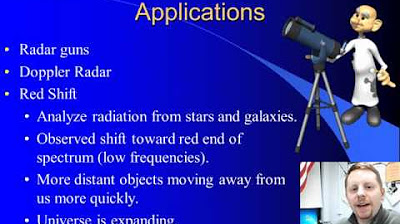Doppler Effect
TLDRThe video script explains the Doppler Effect, a phenomenon where the frequency of waves changes due to the relative motion between a source and an observer. It uses examples such as a siren approaching and receding, a swan swimming in water, and the red shift observed in light from distant galaxies to illustrate how pitch or color changes occur when the source or observer is in motion. The concept is crucial for understanding the expanding universe and has practical applications in various fields.
Takeaways
- 🎶 The Doppler Effect is the change in frequency or pitch of a wave in relation to an observer who is moving relative to the wave source.
- 🚨 When a siren or similar sound source approaches an observer, the pitch increases due to the compression of sound waves.
- 📉 After passing the observer, the pitch decreases as the sound waves spread out.
- 🌊 The principle of the Doppler Effect applies not only to sound waves but also to water waves and light.
- 🦢 Water waves generated by a moving object, like a swimming swan, demonstrate the effect with waves bunching up in front and spreading out behind.
- 🌌 The redshift observed in light from distant celestial objects indicates that these objects are moving away from us, revealing an expanding universe.
- 📊 Waves emitted by a source will be uniformly distributed unless the source is in motion, affecting the observed frequency.
- 🚗 An everyday example of the Doppler Effect is the change in pitch of a car's horn as it passes by a stationary observer.
- 🛶 The Doppler Effect also occurs when the observer is the one moving, affecting how they perceive the frequency of the waves.
- 💡 The frequency of waves increases for an observer approaching the wave source and decreases when moving away.
- 🔵🔴 The color of light is affected by the Doppler Effect, with light appearing more red when moving away and more blue when approaching.
Q & A
What is the Doppler Effect?
-The Doppler Effect is a phenomenon where the frequency of waves received by an observer differs from the frequency emitted by the source due to the relative motion between the source and the observer.
Why does the pitch of a siren change as it approaches and then moves away from an observer?
-As the siren approaches, the sound waves bunch up, leading to an increase in frequency and a higher pitch.
Outlines
🎶 Introduction to the Doppler Effect
This paragraph introduces the Doppler Effect, a phenomenon where the pitch of a sound changes due to the relative motion between the source of the sound and the observer. It explains how the pitch increases as the source approaches and decreases as it moves away, using the example of a siren. The concept is also extended to water waves and the red shift in light, illustrating the effect's relevance to both sound and light waves, and its implication in understanding the expanding universe.
Mindmap
Keywords
💡Doppler Effect
💡Pitch
Highlights
Introduction to the Doppler Effect and its common example of a siren changing pitch.
Explanation of how the Doppler Effect can occur due to the movement of either the source or the observer.
Demonstration of sound waves bunching up in front of a moving object and spreading out behind it.
Illustration of the Doppler Effect using water waves and a swimming swan.
Connection of the Doppler Effect to the red shift observed in light from distant celestial objects.
Hubble's discovery of the universe's expansion through the observation of red shifts.
Explanation of how the observed frequency of waves changes due to motion of the source or observer.
Example of a car approaching and passing by to demonstrate the Doppler Effect's impact on sound frequency.
Discussion on how the Doppler Effect applies to light and the resulting color shifts towards red or blue.
The creation of a wave front diagram to demonstrate the frequency changes as a source approaches and moves past an observer.
The impact of the observer's movement on the frequency of waves they encounter.
How moving towards waves results in an increase in frequency experienced by the observer.
How moving with waves results in a decrease in frequency experienced by the observer.
The stretching of light wavelengths when moving away from a light source, causing a red shift.
The blue shift that occurs when approaching a light source due to the compression of wavelengths.
The significance of the Doppler Effect in understanding the expanding universe and cosmic red shifts.
The practical application of the Doppler Effect in everyday scenarios like a car's siren changing pitch.
The educational value of the wave front diagram in visualizing the Doppler Effect's principles.
Transcripts
5.0 / 5 (0 votes)
Thanks for rating:





